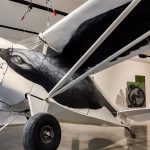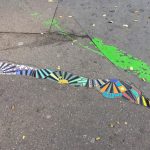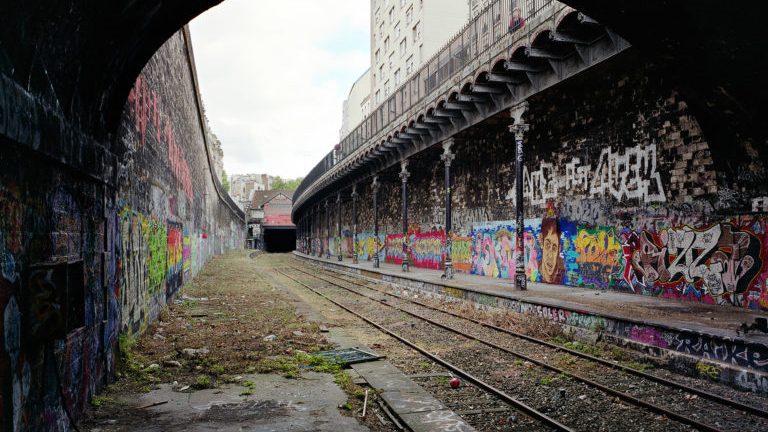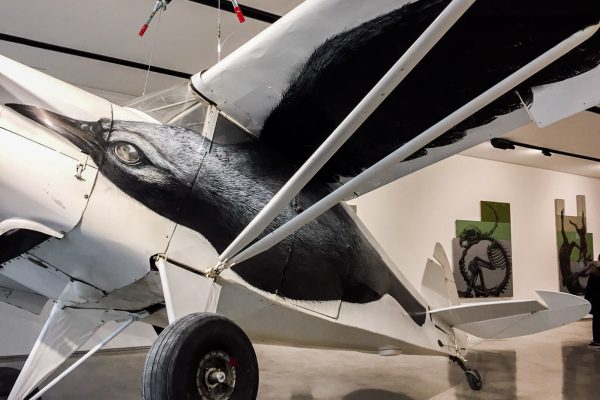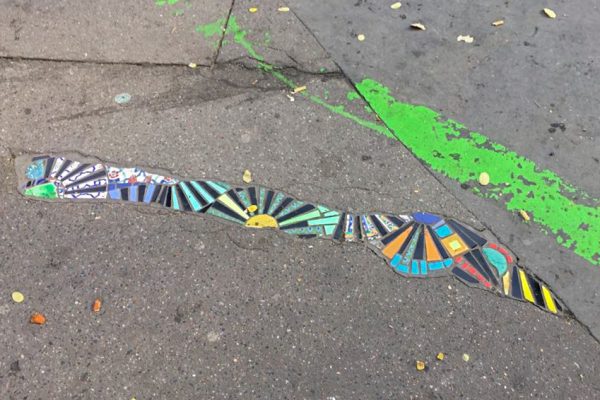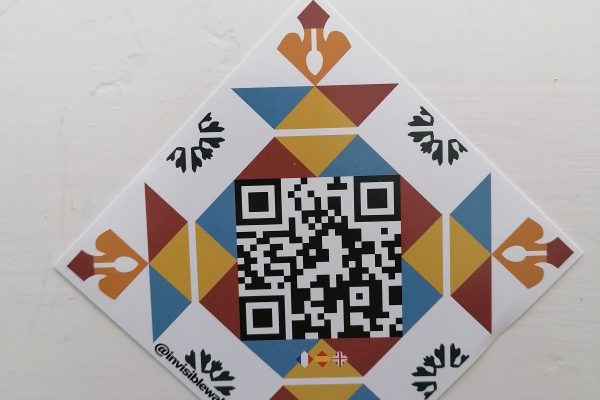Photographer and artist of note, Thomas Jorion captures the beauty of ruins and forgotten heritage. On the terrace of a café on the banks of the Ourcq canal in Paris, we talked about his memories of his childhood and discussed his experience of vandalism, inherent to his urbex approach.
From his first urban explorations to the affirmation of his artistic career, we wanted to know the details of two of his projects that particularly touched us: The Forgotten Line and the Piscine Molitor.
The focus of the series “The Forgotten Line” about the Petite Ceinture (or ‘Little ring’) is an old railway line that surrounds Paris. It is 32 kilometres long and connected thirty stations in the 20th century. Now disused, the stations have been restored as cultural sites and the line has become a promenade.
Also in Paris, in the 16th arrondissement, the Piscine Molitor, was both a swimming pool and a sublime Art Deco building. Closed in 1989, it was listed as a historical monument in 1990 but abandoned, it became a Mecca for Parisian vandal graffiti until the 2000s. It was eventually restored in 2014 as a luxury hotel.
For this interview, we collaborated with the young platform Artenders, a contemporary art media engaged in the promotion of French artists and in the consolidation of a network of art professionals and enthusiasts. To discover their video-portrait of Thomas Jorion (in French), it’s here!
I discovered Thomas Jorion’s work during my internship at the National Monuments Centre last year when I was coordinating an exhibition at Francis I’s castle in Villers-Cotterêts. Before its restoration, Thomas Jorion had come to immortalise the interior of this Renaissance monument and to bear witness to its tumultuous history and the cultural heritage it represents.
I am delighted to have had the chance to meet him again through Invisible Walls for this exciting interview. Enjoy the read 😊
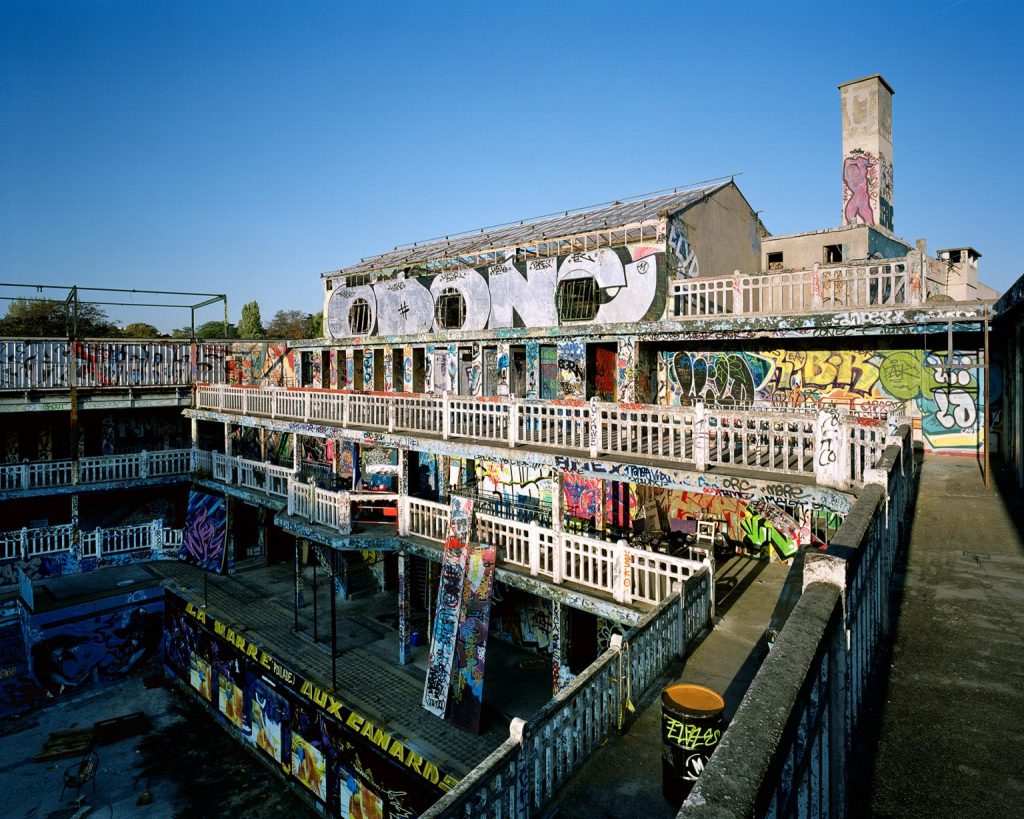


- Why are you photographing abandoned buildings?
It just happened by chance. I grew up in the Val-de-Marne, in Champigny-sur-Marne, and at the time I had a certain passion for films like Indiana Jones or the Goonies. I had made friends in that universe and we liked to go after school or at lunch break to an abandoned garage next to the college. We’d scare each other a little, smoke cigarettes… And eventually, it’s something that lasted. We did some research in the area, even going to city hall, to the map department to see if there were other buildings or abandoned sites in the area. And then we grew up. After graduating from high school, I went to law school without much passion and bought a camera. Spontaneously I wanted to photograph abandoned buildings. I think there was a desire to save them, because I had the feeling that I was photographing buildings that were about to collapse or be damaged.
We didn’t talk about urbex at that time. Today, it’s a practical term.
2. What were your first explorations?
We were very bored and we didn’t have video games or internet so we often went to the abandoned garage next to the college, on the banks of the Marne. The architecture itself wasn’t very interesting but it was nice to go up there. I remember that we could climb up to the roof by passing through a hole with a rope. That was fun! And closer to my house, there was a house from the early 19th century. There was a small pavilion and a canopy at the entrance, and a wooden staircase that went up to the upper floors. That was more impressive because it was a residential interior.
Those were the first two places I explored when I was very young. Later, I moved to Seine-et-Marne and explored castles. The one in Lesigny for example, and the castle of Malnoue, near Pontault-Combault.
3. How do you choose the places you photograph?
In the beginning it was photographing abandoned places for abandoned places sake. From a warehouse, for example the customs warehouse in Pantin, to the Petite Ceinture, to Belgium, to factories, houses, or villas in Italy. It was something that wasn’t really done in photography.
At one point, I realised that I had to organise it as a series or by theme. It had to be tied in with history. I think the most important example was this series on the vestiges of the French colonial empire that I photographed from 2013 to 2016: Vestiges of Empire. It was interesting to go back to those traces of the past. When the coloniser builds a slaughterhouse in Casablanca, he does something that will remain in time by an architectural style, by the fact that all of a sudden it is Europe that builds in the Maghreb.
4. What’s your relationship to street art?
I was in college in 1988-89. It was the beginning of rap, of hip-hop culture in France, and I had friends who were starting to tag in the street. It was great!
Did you try it?
Not much, but it’s something I like, something that touches me, that talks to me!
And of course, abandoned buildings are convenient places for expression. I think at first it bothered me because I liked the immaculate side of them. But it depends on the context. I take the example of the petite Ceinture, I think it’s an element [graffiti] that brings a lot. I really like to find that in certain places.
I remember, for example, the Sudac compressed air factory in the 13th arrondissement, near the Porte d’Ivry, on the banks of the Seine. Today it’s a school of architecture [Ecole Nationale Supérieur d’Architecture Paris Val-de Marne – ENSAPVS] but at the time, when it was abandoned, it was a cathedral of tags. It was really sick in this industrial place! I liked that!
Are there any artists or works of street art that struck you?
I think of the artist André at the time when all of a sudden the guys started to develop another form of art and stand out because I think it’s still relevant today. We always try to stand out by a name, a lettering or a positioning.
5. How much of your practice is vandalism? And how much of your project work are commissioned?
90 or 95% of what I do is unauthorised because it’s too complicated to get permission. You have to identify an owner, explain your approach, and then there are insurance issues as well… Now that I’m starting to be well-known, I’ve been offered commissions, often carte blanche, which is an overview of the property before transformation. For example the castle of Villers-Cotterêts, in such a dilapidated state that it could very well have been photographed like urbex.
Are you attracted to the vandal element?
Obviously, there’s nothing else like that! The adrenaline makes you have an acuity that is increased tenfold and you cut to the essential. Sometimes I find it hard to keep the same rhythm when it’s commissioned. For me, it’s obvious to do in vandal mode. I have access to places that I would never have access to in any other way.
Artenders : What touches me in your work is that you never see the man but you always feel him. Perhaps, with this authorisation, humans have a different place because the space is no longer abandoned. In the same way, street art disturbs this abandonment in your paintings… Your photos, sorry! It’s funny that I say painting because some of them really look like it!
Very often people feel like they’re seeing paintings! I think it’s the fact of using the colour negative, the large film-plans that I use in the darkroom and then the print on fine art paper with a bit of cotton that really gives this impression.
Graffiti all of a sudden takes away the immaculate aspect. It feels more difficult to travel to the place, into the image, because there is a form of appropriation. All of a sudden, it brings us back to reality.
6. I’d like to discuss one of your first projects: la Petite Ceinture. Why did you want to explore it?
I discovered it very early with this same group of friends when we were looking for access to the catacombs. A friend’s cousin told us that there was an entrance in the south of Paris, from a disused railway line. We had no GPS, no internet and the line is more than 30 km long. It is a bit hidden in places, in tunnels or high up, so we didn’t find it directly. We finally found an access further north, towards Porte de Clichy. I found the photos I had taken at the time in argentic, the tunnels at that time were still lit. It was the end of rail traffic [1996] but it still seemed very busy, so we were expecting to run into a train at any moment, or meet people… we were really at a peak of adrenaline.
Then I happened to go back several times. I moved to the 19th arrondissement in the early 2000s and started exploring that part of town. I was getting more and more into photography at that time and testing cameras in those abandoned areas. I had the feeling that it was a world that was going to change, evolve or disappear. I love it very much as it is today: abandoned, wild and tagged. It’s one of the few places where you can no longer hear the noise of the city. It’s a real temporal change.
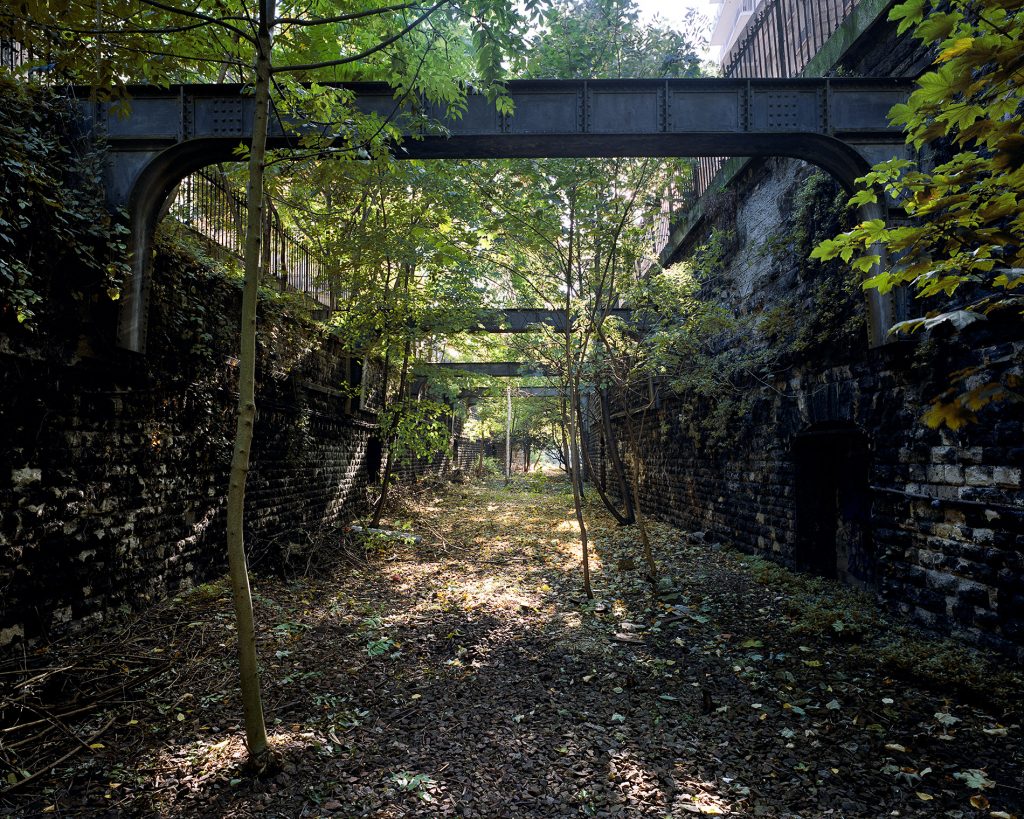


7. Can you tell us about your experience at the Piscine Molitor?
I had discovered it while visiting the greenhouses of Auteuil, another less known abandoned place. In the distance I had seen a building that was full of graffiti and tags. It was the Molitor pool but it was completely closed. Later, I met up with a friend to go there together, around 2010. To get there, we had to get organised. We arrived at night at 5am with a ladder on the car. We climbed up through the roof, went inside and waited for daylight to break and take pictures. And then we realised there was someone there. We thought it was a caretaker, but it was actually an artist who lived there. He helped to regulate the place a little bit. It was a time when it was a little more organised. Before that, I think it was wide open and a lot of street artists went there.
So I first went there in vandal mode at night, and two years later I was able to return there officially to photograph the place before transformation. I had the keys to the place to myself. The artist who was guarding the place was gone.
Today, it has become a palace hotel. They had to demolish 90% of the building to rebuild it identically, which allows them to continue to relay the story.
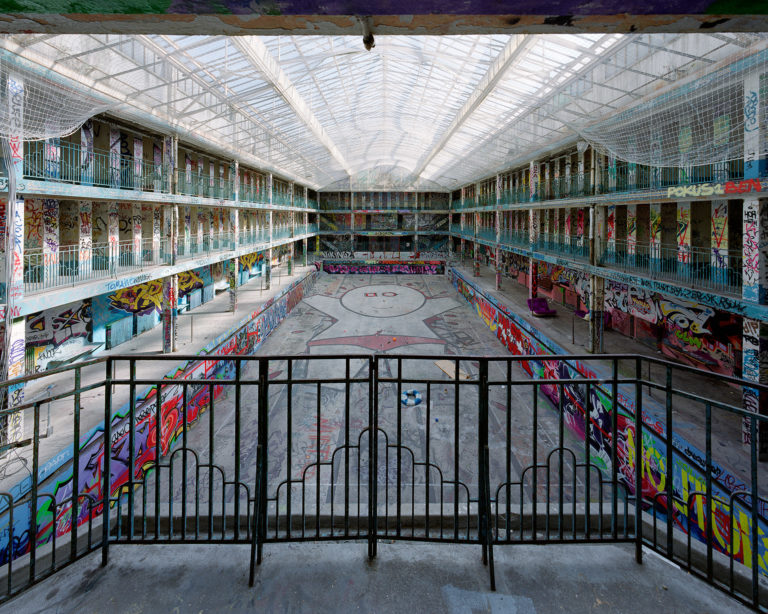


8. Are there any other abandoned places in Paris or the Greater Paris that you haven’t explored yet or that you would like to return to?
I don’t know all of them and there are always small places opening up, buildings, factories… For example, at the moment there is a factory in the south of Paris being dismantled. And then, I still go to the Petite Ceinture from time to time. I went there not even a month ago. What I like about the Petite Ceinture is that at all times in my career it has always brought me new things. When I wanted to photograph architecture, there were things to be found there. If I was looking for human beings, there are people who live there. That’s what I like a lot about this Petite Ceinture, which will gradually disappear. It’s a place of freedom where you can go and do what you want. By the way, you asked me if I had been tagging: I had tried stenciling, I had forgotten! At one point I felt like stenciling, I wandered around on the Petite Ceinture at night and I made stencils!
As usual, we are suggesting a few additional resources to help you explore the subject a bit further:
– Thomas Jorion’s website to discover the exhaustiveness of his work.
– The Forgotten Line, an article about the Little Ring as a medium for architecture and urban planning.
– Molitor, This is not a swimming pool, Ludovic Roubaudi & Thomas Jorion (2019): a book retracing the history of the Molitor swimming pool with Thomas Jorion’s photographers. In French and English.
